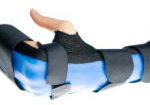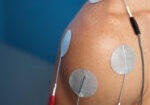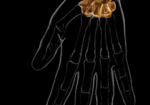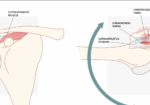What is Chronic Exertional Compartment Syndrome? Overview and Hand Therapy Treatment Ideas
Filed under Evaluation
Compartment syndrome is a condition characterized by increased pressure within a compartment of the body, leading to pain, swelling, and reduced tissue perfusion (Barkay et al., 2021; Buerba et al., 2019). It can be either acute or chronic (Barkay et al., 2021). Chronic exertional compartment syndrome (CECS) is a rare type, most commonly observed in athletes, particularly rowers and motorcyclists when the upper extremity is involved, though it can occur in anyone (Buerba et al., 2019; Cole et al., 2017). CECS is characterized by a gradual and reversible buildup of pressure within the compartment, leading to progressive pain and edema, typically triggered by activity. This occurs due to muscle hypertrophy, microtraumas, and a noncompliant fascia (Buerba et al., 2019; Ogrodnik et al., 2021). Patients often report persistent pain that worsens with repetitive movements (Cole et al., 2017).
Treatment Options for CECS
CECS is often managed conservatively, though surgical options are available if symptoms persist and interfere with daily activities.
Conservative Treatments
Conservative management typically includes massage, stretching, and activity modification (Buerba et al., 2019).
Manual therapy:
For massage and stretching techniques, a five-week course of a massage regimen and stretching home exercise program is found to decrease post-exercise pain (Blackman et al., 1998). A study concluded this is due to increased compartmental volume post massage due to fascial stretching, or due to individuals’ increased pain thresholds due to neural receptor alterations in the fascia or muscle changes (Blackman et al., 1998).
Biofeedback:
A way to treat this syndrome is to provide activity modification education. Furthermore, chronic compartment syndrome is often referred to as chronic exertional compartment syndrome because it is typically exercise induced (Buerba et al., 2019). This is achieved through providing biofeedback during activity modification and retraining interventions (M. Materi, personal communication, September 14, 2023; Zimmerman et al., 2017). Biofeedback provides visual feedback concerning the force a muscle compartment is exerting (Larsen et al., 2014; M. Materi, personal communication, September 14, 2023).
Figure 1: mTrigger biofeedback device Figure 2: mTrigger biofeedback device
https://www.mtrigger.com/biofeedback-occupational-hand-therapy/

Grips:
Furthermore, larger handles would help activity modification (M. Materi, personal communication, September 14, 2023). Since chronic exertional compartment syndrome is typically seen in rowers and motorcyclists which are occupations that demand high grip strength and continued use, creating larger grips could modulate the grip strength required to handle an object (Buerba et al., 2019; M. Materi, personal communication, September 14, 2023; Sheerin et al., 2023). Changing grip handles will change the amount of force and positioning a patient exerts into an activity which will change the repetitive motion they have been utilizing (M. Materi, personal communication, September 14, 2023; Zimmerman et al., 2017; Schubert, 2011).
Figure 2: Built up handle

Overall, chronic exertional compartment syndrome can be treated conservatively, but individuals have the option of undergoing a fasciotomy if symptoms persist that interfere with their everyday living.
References
Barkay, G., Zabatani, A., Menachem, S., Yaffe, B., & Arami, A. (2021). Acute compartment syndrome of the upper extremity: Clinical outcomes following surgical treatment. A retrospective cohort study. The Israel Medical Association Journal, 23(8), 516–520.
Blackman, P. G., Simmons, L. R., & Crossley, K. M. (1998). Treatment of chronic exertional anterior compartment syndrome with massage: A pilot study. Clinical Journal of Sports Medicine, 8(1), 14–17. https://doi.org/
Buerba, R. A., Fretes, N. F., Devana, S. K., & Beck, J. J. (2019). Chronic exertional compartment syndrome: Current management strategies. Open Access Journal of Sports Medicine, 2019(10), 71–79.
Cole, A., Hiatt, J. L., Arnold, C., Sites, T., & Ylanon, R. (2017). Chronic exertional compartment syndrome in the forearm of a collegiate softball pitcher. Sports Medicine – Open, 3(1), 11.
Larsen, C. M., Juul-Kristensen, B., Olsen, H. B., Holtermann, A., & Søgaard, K. (2014). Selective activation of intra-muscular compartments within the trapezius muscle in subjects with subacromial impingement syndrome. A case-control study.Journal of Electromyography and Kinesiology,24(1), 58–64.
Ogrodnik, J., Oliver, J. D., Cani, D., Boczar, D., Huayllani, M. T., Restrepo, D. J., Sisti, A., Manrique, O. J., Broer, P. N., & Forte, A. J. (2021). Clinical case of acute non-traumatic hand compartment syndrome and systematic review for the upper extremity. Hand, 16(3), 285–291.
Schubert, A.G. (2011). Exertional compartment syndrome: Review of the literature and proposed rehabilitation guidelines following surgical release. International Journal of Sports Physical Therapy, 6(2), 126–141.
Sheerin, M., O’Riordan, C., Conneely, M., Carey, L., Ryan, D., Galvin, R., & Morrissey, A. M. (2023). Effectiveness of occupational therapy interventions on function and occupational performance among adults with conditions of the hand, wrist, and forearm: A systematic review and meta-analysis. Australian Occupational Therapy Journal, 1-15.
Zimmermann, W. O., Linschoten, C. W., & Beutler, A. (2017). Gait retraining as part of the treatment programme for soldiers with exercise-related leg pain: Preliminary clinical experiences and retention. South African Journal of Sports Medicine, 29(1), 1-6.
More To Read
Flexor tendon rehabilitation in the 21st century: A systematic review
Neiduski, R. L. & Powell, R. K. (2019). Flexor tendon rehabilitation in the 21st century: A systematic review. Journal of Hand Therapy, 32, 165-174. The Skinny The objective of the study was to determine if there was evidence to support 1 type of exercise regimen. Exercise regimens reviewed include place and holds, early passive or…
Read MoreThe Use of Neuromuscular Electrical Stimulation with Upper Extremity Paralysis
The Use of Neuromuscular Electrical Stimulation with Upper Extremity Paralysis By: Mikayla Murphy Martin, R., Johnston, K., & Sadowsky, C. (2012). Neuromuscular electrical stimulation–assisted grasp training and restoration of function in the tetraplegic hand: A case series. The American Journal of Occupational Therapy, 66(4), 471-477. https://doi.org/10.5014/ajot.2012.003004 The Skinny The purpose of the study was to…
Read MoreCarpal Fractures: A Brief Overview
Carpal fractures account for 8% of fractures in the upper extremity. The carpals are situated between the (distal radius and ulna) and the metacarpals. They make up the proximal row- Scaphoid, Lunate, Triquetrum, and Pisiform, the distal row- Trapezium, Trapezoid, Capitate, and Hamate. Here are some of the most common carpal bone fracture Scaphoid…
Read MoreShoulder Pain: The Effectiveness of Conservative Treatment
Reference: Steuri, R., Sattelmayer, M., Elsig, S., Kolly, C., Tal, A., Taeymans, J., & Hilfiker, R. (2017). Effectiveness of conservative interventions including exercise, manual therapy and medical management in adults with shoulder impingement: a systematic review and meta-analysis of RCTs. British journal of sports medicine, 51(18), 1340–1347. https://doi.org/10.1136/bjsports-2016-096515 By: Tayler Roost The Skinny: This study…
Read MoreSign-up to Get Updates Straight to Your Inbox!
Sign up with us and we will send you regular blog posts on everything hand therapy, notices every time we upload new videos and tutorials, along with handout, protocols, and other useful information.






